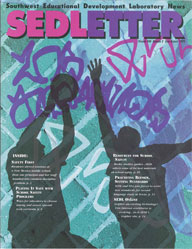Editor's Note: Making Schools Safe
Everyone wants to make schools safer for children and youth. It is an issue that unites educators, policymakers, and the public alike. But while there is consensus about the goal of establishing safe schools, there is contention about the best methods of achieving that goal.
One element complicates this debate for some school administrators: experience has taught them that issues of discipline and school safety are intertwined-particularly when it is the students themselves who bring danger on campus.
Yet a New Mexico school principal found that the students who were causing safety problems could be allies in resolving them. "Safety First" presents the practices Carmen Holguin used to increase school safety and reduce group rivalries at her middle school. These approaches employ a surprisingly light disciplinary touch; perhaps that is why they also successfully engaged at-risk students as agents of positive change.
While Holguin and her staff devised their own responses to school safety issues, many other school administrators are implementing school safety programs and curricula created by third-party vendors. Unfortunately, some of these packages are reaching the schools before the outcomes they claim have been proven in field tests. In "Playing It Safe with School Safety Programs," two experts in program evaluation recommend how educators might investigate these specialized programs before buying them.
Other features include a collection of recent research publications focusing on school safety and an announcement of a newly funded program that will engage Texans in developing new curriculum and assessment standards for second language study in Texas schools.
Next Article: Safety First: A New Mexico Middle School Safeguards Students by Diffusing Clique Rivalries

